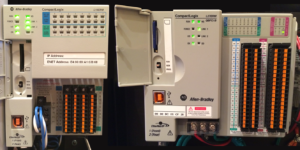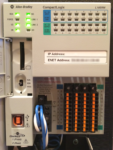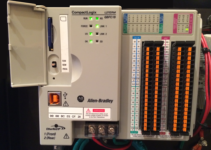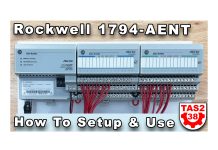At the end of a very hectic couple of weeks teaching Logix and View introductory classes, I thought I would share seven more things you need to know about the current generation of CompactLogix 5370 controllers.
NOTE: To find out the first seven things you should know about the current generation of CompactLogix, check out our previous article HERE.
Seven more things you need to know about the current generation of CompactLogix
1) Mode Switch is now a toggle switch
 This seems to be a growing trend with Allen-Bradley PLC’s… well at least on the low end models.
This seems to be a growing trend with Allen-Bradley PLC’s… well at least on the low end models.
Personally, I prefer the ruggedness of the old key switch, and the ability to lock the controller in either Run or Program mode.
2) Built-in dual port Ethernet switch
Having built-in Ethernet is not new to the CompactLogix line, as the L32E and L35E both supported a front facing port.
But these new 5370 models now sport a two port Ethernet switch on the bottom of the unit.
This allows the small machine builder to eliminate a switch by using one port for his HMI, and the second port as a programming port for either device.
It also allows for the daisy chaining of devices when used with other two port Ethernet devices, or for ring configurations when used with other devices supporting Device Level Ring (DLR) technology.
3) Ethernet port now supports Open Sockets
While some may bemoan the loss of the DB9 serial port, the addition of “open sockets” support via the Ethernet port more than makes up for it.
The “open sockets” support gives the 5370 CompactLogix the ability to communicate over Ethernet to bar-code readers, printers, and even devices using Modbus TCP with a free AOI.
4) CIP and TCP connections greatly increased
The old L32E and L35E has some serious connection limits, only supporting 32 of each.
The 5370 CompactLogix now supports 120 TCP connections, and 256 CIP connections.
This results in configurations with plenty of connections left over for HMI and SCADA systems even after the Ethernet I/O limits have been reached.
5) Ethernet I/O limits per model
 With previous CompactLogix products, a manual calculation or separate utility was needed to insure a design didn’t exceed the product’s connection limit.
With previous CompactLogix products, a manual calculation or separate utility was needed to insure a design didn’t exceed the product’s connection limit.
Now, each 5370 CompactLogix has a published number of supported Ethernet I/O drops, simplifying design decisions.
Here’s a quick rundown of each models Ethernet I/O drop limits:
- L16ER: 4
- L18ERx: 8
- L24ER: 8
- L27ERM: 16
- L30ERx: 16
- L33ERx: 32
- L36ERM: 48
6) Local I/O limits per model
Just like with previous CompactLogix processors, each model supports a limited number of local I/O.
Below is a quick rundown of each models limit:
- L16ER: 6 Point I/O Modules
- L18ERx: 8 Point I/O Modules
- L24ER: 4 Compact I/O Modules
- L27ERM: 4 Compact I/O Modules
- L30ERx: 8 Compact I/O Modules
- L33ERx: 16 Compact I/O Modules
- L36ERM: 30 Compact I/O Modules
7) CIP Motion support
 Finally, each of the new 5370 CompactLogix lines has at least one model with CIP Motion support. This support is indicated by the M in the part number.
Finally, each of the new 5370 CompactLogix lines has at least one model with CIP Motion support. This support is indicated by the M in the part number.
Below is a quick rundown of each models CIP Motion Servo Drive limit:
- L18ERM: 2
- L27ERM: 4
- L30ERM: 4
- L33ERM: 8
- L36ERM: 16
I hope this additional article about the new features of the 5370 CompactLogix was helpful!
If you have any questions, suggestions, comments, or corrections please don’t hesitate to leave them with us by using the “post a comment or question” link below,
Until next time, Peace ✌️
If you enjoyed this content, please give it a Like, and consider Sharing a link to it as that is the best way for us to grow our audience, which in turn allows us to produce more content 🙂
Shawn M Tierney
Technology Enthusiast & Content Creator
Support our work and gain access to hundreds members only articles and videos by becoming a member at The Automation Blog or on YouTube. You’ll also find all of my affordable PLC, HMI, and SCADA courses at TheAutomationSchool.com.
- FactoryTalk Design Workbench First Look, CCW Comparison - December 19, 2025
- Drew Allen of Grace Technologies on Automation, Safety, and More (P256) - December 17, 2025
- Robotics in Warehouse Automation with Erik Nieves of Plus One Robotics (P255) - December 10, 2025

Discover more from The Automation Blog
Subscribe to get the latest posts sent to your email.




Hello,
I always thought that the number of ethernet IO (e.g. Powerflex, PoinIO, FlexIO…) was the CIP connections. Would you please explain what is a CIP connection?
Also, I have a L32E, how would I know the number of ethernet IO device I can add in my IO config?
Thanks a lot!
Good morning Frédérick,
These new CompactLogix have a hard set Ethernet I/O drop limit so we no longer have to count CIP and TCP connections to find out how many IO drops we can have.
In addition, because the TCP and CIP connection count Is so high, we typically worry more about the loading our HMI or SCADA will put on the processor itself versus how many connections they will take.
However, on the previous models like your L32E, we still do need to count CIP and TCP connections to be sure our total network connection limit is not eclipsed. And the easiest way to do that is to use the Ethernet IP Capacity tool:
http://www.theautomationblog.com/estimating-bandwidth-using-the-free-ethernetip-capacity-tool/
While Rockwell has written entire documents on the nature of a “connection,” I use this “rule of thumb,”
– At least 1 TCP connection is required for each device the processor communicates to on Ethernet.
– At least 1 CIP connection will be needed for each rack of digital I/O added to the I/O tree
– At least 1 CIP connection will be needed for each analog I/O module added to the I/O tree
– PanelView Plus HMI’s can take up to 5 CIP connections
In the article I link to above, the Point IO racks I add to the EIP tool have 2 analog cards each, and each rack consumes 4 cip connections. I then add PF525 drives which take 1 CIP connection each, and then PanelView Plus HMI’s which take 5 CIP connections each.
Hope this helps,
Shawn Tierney
[sc name="stsigcom"]
Hello Terry,
Can you get me a link to the Modbus AOI?
Is there a way that I can look at your example on how to implement the Modbus AOI?
Thank you in advance.
Good morning,
If you search for “Modbus TCP” at http://samplecode.rockwellautomation.com you can download it for free, and it comes with a fairly good PDF manual,
Hope this helps,
Shawn Tierney
[sc name="stsigcom"]